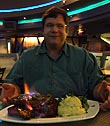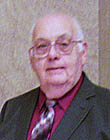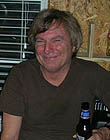|
|
This topic comprises 3 pages: 1 2 3
|
|
Author
|
Topic: LP maximum playing time
|
|
|
|
|
|
|
|
|
|
|
|
|
Leo Enticknap
Film God

Posts: 7474
From: Loma Linda, CA
Registered: Jul 2000
|
 posted 04-01-2006 04:30 AM
posted 04-01-2006 04:30 AM





As a very rough rule of thumb and on the basis of my collection, I'd say that you'll start to hear a serious loss of HF if the playing time per side goes over 25 minutes.
I have one recording of Beethoven's 9th crammed onto a single LP: movements 1,2 and about 5 minutes of movement 3 are on side 1 (around 33 minutes I'd guess) with the rest on side 2. Because the disc is cut so close to the label rim, it needs an extra half a gram of tracking force to stop the needle jumping during the last 5 minutes or so of each side. The signal level is really low, too, and that record really doesn't do the performance justice. Interestingly, this is a Deutsche Grammophon LP and they're not known for cutting corners on technical quality. It was one of the last LPs they produced (1989), and by that time most serious classical music buffs had probably gone to CD. If the recording hadn't been made to commemorate the fall of the Berlin Wall, I doubt if they'd have released an LP version at all. I bought it in the early '90s for 50p, during that crazy period from around 1990-95 when you could buy remaindered stock of unsold LPs in pristine, unplayed condition for stupidly low prices. I bought a pristine Verve 1980s DMM repressing of Oscar Peterson Plays the Gershwin Songbook for 99p that day, too. It's probably worth quite a bit now.
| IP: Logged
|
|
|
|
|
|
Monte L Fullmer
Film God

Posts: 8367
From: Nampa, Idaho, USA
Registered: Nov 2004
|
 posted 04-01-2006 02:32 PM
posted 04-01-2006 02:32 PM




quote:
I have one recording of Beethoven's 9th crammed onto a single LP:
Columbia ML-5200 (1956) with Walter and the PSofNY is a single LP recording of the 9th as well..the 3rd mvt was split in half so the recording could fit on one vinyl.
Everest did the same thing with their vinyl mastering of the 9th with Krips and the LSO (recording mastering was using the 35mm method using the Fairchild recorders..).
This is a common mastering practice for this particular piece if one vinyl album is to be released..
quote: Kenneth Wuepper
The variable pitch lathes were very expensive, not that this made any difference at the time.
..but Mercury's queen, Wilma Cozart, along with her "future" husband Bob Fine, didn't let this stop them in making their "Living Presence" vinyls - starting in 1951 with the Reeves-Fairchild "Margin Control" Process. Their lacquer engineer, George Piros mastered this "margin control" process of the variable groove spacing, thus creating the first "hi-fi" record that was capable of capturing the full audio spectrum on vinyl. Later on, George developed a Scully lathe as his favorite to use and would inscribe on the master lacquer "P-17" that can be seen in the deadwax area of the vinyl releases.
quote: Michael Schaffer
Obviously, quality deteriorated gradually towards the centre of the LP because of slower groove speeds and of the increasingly steep stylus angle
Probably why Deutsche Grammophon, in their early stereo LP's, left so much dead wax in the middle - to eliminate the quality dedregration and to maintain audio output quality throughout the side of the vinyl.
RCA, to "hide" this effect and to make smaller portable units sound good, came out with their hideous "Dynagroove" process in 1963, which did work (for the portable units) but sounded extremely bloated for the audiophile units due to massive bass emphasis.
-Monte
| IP: Logged
|
|
|
|
|
|
|
|
|
|
|
|
|
|
All times are Central (GMT -6:00)
|
This topic comprises 3 pages: 1 2 3
|
Powered by Infopop Corporation
UBB.classicTM
6.3.1.2
The Film-Tech Forums are designed for various members related to the cinema industry to express their opinions, viewpoints and testimonials on various products, services and events based upon speculation, personal knowledge and factual information through use, therefore all views represented here allow no liability upon the publishers of this web site and the owners of said views assume no liability for any ill will resulting from these postings. The posts made here are for educational as well as entertainment purposes and as such anyone viewing this portion of the website must accept these views as statements of the author of that opinion
and agrees to release the authors from any and all liability.
|

 Home
Home
 Products
Products
 Store
Store
 Forum
Forum
 Warehouse
Warehouse
 Contact Us
Contact Us




 Printer-friendly view of this topic
Printer-friendly view of this topic














![[Big Grin]](biggrin.gif)




